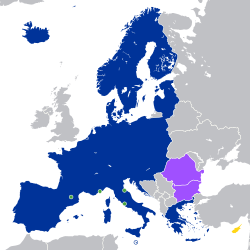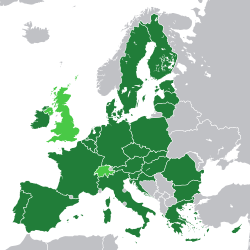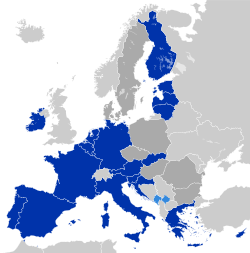European Travel Information and Authorisation System

 Map of Europe Schengen Area Countries with open borders to the Schengen area Member of the EU committed by treaty to join the Schengen Area in the future | |
| Policy of | |
|---|---|
| Type | Electronic travel authorisation system area |
| Expected implementation | Last quarter of 2026 |
| Applicable countries | 30 countries +4 countries and 1 territory indirectly
|

| This article is part of a series on |
 |
|---|
| |
The European Travel Information and Authorisation System (ETIAS) is a planned electronic authorisation system of the European Union for visa-exempt visitors travelling to the Schengen Area (including EFTA countries), as well as Cyprus. ETIAS is planned to cost €7 for applicants between ages 18 and 70, and to remain valid for three years or until the expiry date of the passport, whichever is sooner.[1] ETIAS is planned to come into force in the last quarter of 2026, approximately a year after implementation of the Entry/Exit System.[2]
According to the European Commission, ETIAS is planned to be implemented "for the identification of security, irregular migration or high epidemic risks posed by visa-exempt visitors."[3] It is not a visa,[4][5] and it does not guarantee entry.[6]
ETIAS was first proposed by the European Commission in 2016[7] and was formally established by Regulation (EU) 2018/1240 of the European Parliament and of the European Council of 12 September 2018.[8][9] Due to various reasons, including difficulties in integrating different member states' national systems into a central database, the implementation date has been repeatedly delayed from January 2021.[10][11]
ETIAS is similar to other electronic travel authorisation systems, such as the United States Electronic System for Travel Authorization (ESTA)[12] and the United Kingdom Electronic Travel Authorisation (ETA).
Applicable nationalities
[edit]ETIAS is required for entry by land, air and sea to 30 European countries, including the 29 member states of the Schengen Area, as well as Cyprus. Ireland, which is part of the Common Travel Area, is the only member state of the European Union that continues to have its own visa policy and does not plan to join the Schengen Area or to require ETIAS.[13]
Visitors who have dual nationality of an EU or Schengen country and of a visa-exempt country (for example, Italy and Canada) will not need ETIAS travel authorisation if they hold a travel document from the EU or Schengen country.[14][15]
As of entering into use, ETIAS will be required from nationals of visa-exempt third countries (Annex II)[16] except the European microstates of Andorra, Monaco, San Marino and Vatican City.
However, ETIAS will not be required from holders of visas, residence permits, local border traffic permits; EU/Schengen nationals or their family members holding a residence card; refugee or stateless travel documents issued by an EU or Schengen country. Crew members; holders of diplomatic or official passports and airport transit passengers are also exempt.[8]
As of 2025[update], holders of ordinary passports of the following countries and territories would match the ETIAS criteria:[17]
Application process
[edit]All prospective visitors will need to complete an online application, and those between ages 18 and 70 must pay a fee of €7.[14] It is estimated that 1.4 billion people will need to apply.[6] The system is expected to process the vast majority of applications automatically by searching in electronic databases and providing an immediate response, but in some limited cases it may take up to 30 days.[18][1] If approved, the authorisation will be valid for three years or until the expiry date of the travel document, whichever is earlier.[1]
Introduction timeline
[edit]After ETIAS comes into force, it will commence with a "transitional period" of at least six months, during which time applications will be accepted, but it will not be mandatory to hold an ETIAS in order to travel. Afterwards, there will be a "grace period" of at least six months, where an ETIAS will be required, but those entering the ETIAS zone for the first time since the start of the transitional period will be allowed to enter.[19]
Limited validity ETIAS
[edit]Travellers who have been refused an ETIAS or expect their ETIAS may not be accepted may apply for a limited validity ETIAS if they have "humanitarian reasons or important obligations" for their travel. It will be valid only for specified countries and for up to 90 days.[20]
See also
[edit]- Visa policy of the Schengen Area
- Entry/Exit System
- Electronic System for Travel Authorization (United States)
- Electronic Travel Authority (Australia)
- Electronic Travel Authorization (Canada)
- New Zealand Electronic Travel Authority
- Electronic Travel Authorisation (United Kingdom)
Notes
[edit]- ^ Excluding Northern Cyprus.
- ^ Including the Faroe Islands and Greenland, which are outside the Schengen Area but maintain travel without border control with the Schengen Area and use the same list of visa-exempt nationalities.
- ^ Including Åland.
- ^ Excluding Overseas France.
- ^ Excluding the Dutch Caribbean.
- ^ Excluding Svalbard and dependencies.
- ^ Including Azores and Madeira.
- ^ Including the Canary Islands, Ceuta, Melilla and plazas de soberanía.
- ^ Maintains open borders with Cyprus and applies the same visa requirements.
- ^ a b c Accessible only from the Schengen Area, with open borders.
- ^ Accessible only from the Schengen Area, with open borders, or by sea with the same visa requirements.
- ^ Including all classes of British nationality, and except those benefitting from the Brexit withdrawal agreement
References
[edit]- ^ a b c "Security union: A European Travel Information and Authorisation System – Questions & answers". European Commission. 5 July 2018. Archived from the original on 31 December 2019. Retrieved 14 August 2021.
- ^ "Revised timeline for the EES and ETIAS - European Union". travel-europe.europa.eu. Retrieved 8 March 2025.
- ^ "Schengen, borders and visa". Europa. 23 November 2022. Archived from the original on 4 August 2023. Retrieved 4 August 2023.
- ^ "Precisiones acerca de ETIAS, el registro de viaje a Europa que aplicará a partir de 2023 | EEAS". Europa. Archived from the original on 9 September 2023. Retrieved 9 September 2023.
- ^ "FAQs on ETIAS - European Union". travel-europe.europa.eu. Retrieved 9 December 2024.
- ^ a b Chung, Christine (3 August 2023). "The E.U.'s New ETIAS Entry Requirement Is Coming. Someday". The New York Times. Archived from the original on 4 August 2023. Retrieved 4 August 2023.
- ^ "Communication from the commission to the European Parliament and the Council, Stronger and Smarter Information Systems for Borders and Security". Europa. 6 April 2016. Archived from the original on 11 September 2023. Retrieved 22 September 2023.
- ^ a b "Official Journal of the European Union, L 236, Volume 61, English Edition". Europa. 19 September 2018. Archived from the original on 15 August 2021. Retrieved 15 August 2021.
- ^ "Security union: A European Travel Information and Authorisation System – Questions & answers". Europa. 5 July 2018. Archived from the original on 31 December 2019. Retrieved 15 August 2021.
- ^ Calder, Simon (20 December 2023). "New border system for entering the EU finally gets 2024 launch date". The Independent.
- ^ Januzi, Shkura (21 June 2024). "1.4 Billion People Will Have to Apply for an ETIAS Authorisation Before Travelling to EU by Mid-2025". Schengen News.
- ^ "US citizens will need to register to visit parts of Europe starting in 2021". CNN. 9 March 2019. Retrieved 14 August 2021.
- ^ "Will you need a visa to visit Ireland in 2021?". IrishCentral. 8 March 2019. Archived from the original on 9 March 2019. Retrieved 15 August 2021.
- ^ a b "Frequently asked questions about ETIAS". Europa. Retrieved 11 November 2024.
- ^ "Who should apply – Who does not need an ETIAS travel authorisation". Europa. Retrieved 11 November 2024.
- ^ Regulation (EU) 2018/1806 of the European Parliament and of the Council of 14 November 2018 listing the third countries whose nationals must be in possession of visas when crossing the external borders and those whose nationals are exempt from that requirement OJ L 303, 28 November 2018, pp. 39–58 Archived 26 December 2018 at the Wayback Machine
- ^ "Who should apply - European Union". travel-europe.europa.eu. Retrieved 6 January 2025.
- ^ "Brexit: No visa but Britons will pay €7 to travel to EU countries". BBC. 14 December 2018. Archived from the original on 14 December 2018. Retrieved 14 August 2021.
- ^ "ETIAS timeline explained". Europa.eu. 24 November 2023. Retrieved 2 January 2025.
- ^ "ETIAS travel authorisation with limited validity". Retrieved 2 January 2025.


